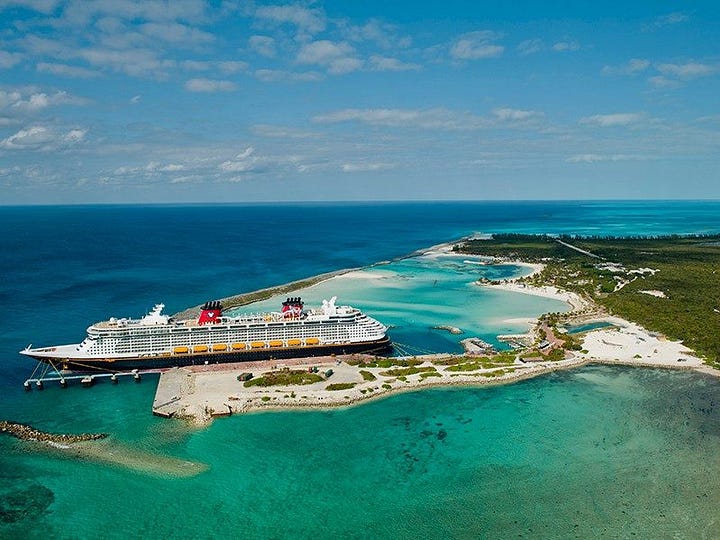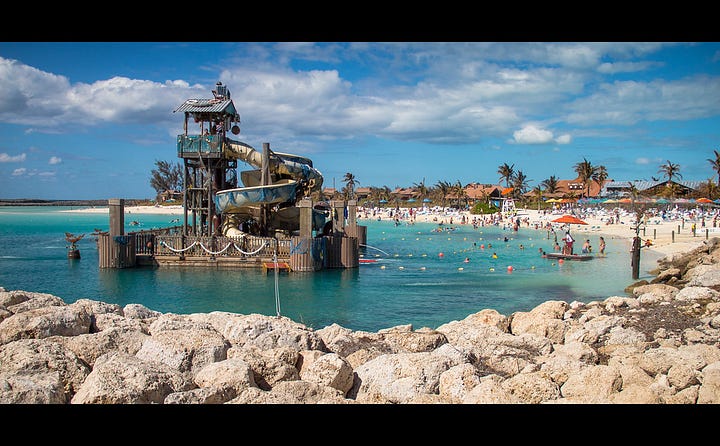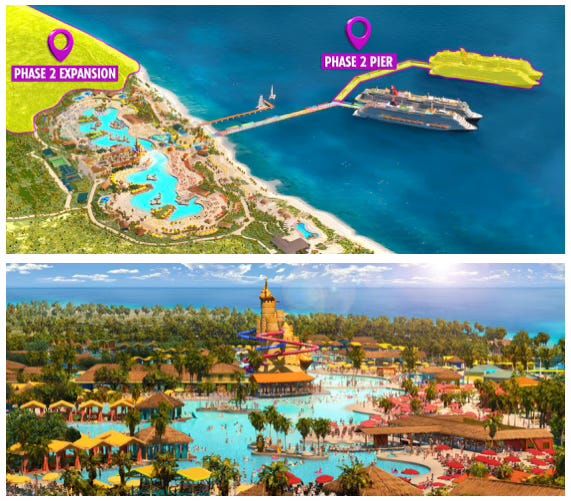#26: Private Island 2.0
All the major cruise companies are making big investments in private islands. What's driving this?
Cruise companies have visited private islands for several decades - usually sleepy Bahamian islands with rudimentary facilities. Guests tender ashore on shuttle boats, sunbathe, and eat a simple buffet or bbq lunch catered from the ship.

Opened in the late 1970s, NCL’s Great Stirrup Cay was the first cruise private island. It had basic facilities (shacks and lounge chairs) and guests went ashore on landing craft, since there was no dock.
Over the 1980s and 90s, Royal Caribbean (Coco Cay, Labadee), Princess (Princess Cay), and Holland America (Half Moon Cay) acquired Bahamian islands on the template of NCL’s Great Stirrup Cay.
Developments in the late 1990s and 2000s


In 1997, Disney launched their first ship and opened a Bahamian island called Castaway Cay. It was similar to other private islands (though a bit higher quality), but Disney built a full-size dock and dredged an approach channel, allowing their guests to walk directly off their ship. For the next few decades, Castaway Cay was considered the gold standard of private islands, but other operators didn’t copy it. Disney commands a massive price premium, and it’s hard to know how much is attributable to a better private island vs the Disney brand overall.
A second development over the 2000s was Carnival Corp’s construction of four Caribbean ports:
Amber Cove, Dominican Republic
Grand Turk, Turks & Caicos
Puerto Maya in Cozumel, Mexico
Mahogany Bay in Roatan, Honduras (recently renamed Isla Tropicale)
Financial analysts often lump these into the generic “private destination” category, since Carnival calls them their exclusive distinations, after all. However, these private ports are categorically different from private islands/destinations:
First, they’re not particularly exclusive. Three of the four ports can be better characterized as Carnival-owned piers at destinations that also have non-Carnival docks. Other companies can still visit these places.
Second, from a passenger perspective, private ports are not meaningfully differentiated from normal cruise ports - their purpose is to enable visitation and tours. Some ports have nice beach areas, but the facilities are not as extensive as private islands.
From a corporate strategy perspective, the purpose of these private ports is 1) to secure docking rights for the ships in perpetuity and 2) to vertically integrate, locking in lower ports costs. In contrast, the purpose of a private island is to offer a full-day, differentiated experience (in addition to guaranteed docking rights and vertical integration).
In 2019, “Perfect Day at Coco Cay” demonstrated a new playbook
In 2019, Royal Caribbean changed the game by opening “Perfect Day at Coco Cay,” essentially a renovation of their existing private island, Coco Cay. They spent $250 million on amenities (waterpark rides, cabanas, overwater bungalows, huge swimming pools, swim-up bars, and plentiful beach space) and infrastructure (docking space for two ships, allowing guests to walk off the ship). Most importantly, the upgrades meant the island could accommodate two of Royal’s biggest ships (5,000+ people each) without crowding. I visited in 2022 and was surprised by how calm it felt.
After opening, Royal Caribbean executives stated that itineraries with “Perfect Day” commanded higher prices and that guest satisfaction scores were the highest of any port they visit. Royal Caribbean had hit on a new formula, which I call Private Island 2.0: Invest hundreds of millions in destination improvements, market the heck out of them, and consumers will pay more.
Following the success of Coco Cay, Royal announced a new “Perfect Day” destination in Mexico. They’re also planning a new private “beach club” concept, which will open in Nassau, Cozumel, and Vanuatu. Royal clearly sees an opportunity to differentiate by creating seamless, high-quality beach experiences (which can be surprisingly hard to find at the mass-market cruise ports).
Carnival’s big investment in private destinations
Now, Carnival Corp is enthusiastically embracing the Private Island 2.0 strategy as well. In 2023, they announced “Celebration Key” - a new Bahamian destination that is clearly inspired by “Perfect Day,” down to the cheesy name. Royal Caribbean took a $250 million risk, told the world how well it worked, and Carnival is copying to the tune of $600+ million. Here’s Carnival’s CEO:
Some are doing better than others, and better than us, turning their own destinations into something that not only guests but non-cruisers look at and decide 'that's going to help tilt my vacation decision to take a cruise. […]
We have not, historically, done a good enough job in raising the level of awareness on the amazing destinations that we have and are in the pipeline.
Josh Weinstein, Carnival Corp CEO on Q4 earnings call, via Travel Weekly
We can expect more investment in private destinations. In fact, Celebration Key hasn’t opened yet and Carnival is already doubling down. Original plans were for two berths (the same number as Royal’s Coco Cay), but in 2024 they increased the planned capacity to four ships.

A few months ago, Carnival announced a separate project to add two incremental berths at Half Moon Cay, a project they’re calling “RelaxAway at Half Moon Cay” (the names, I know 🙄). That’s six “Private Islands 2.0” berths, on top of the three anchorages they have at their original islands (two at Half Moon Cay, one at Princess Cay). Extremely aggressive.
Lastly, Carnival is renovating and renaming their private port in Honduras to Isla Tropicale, adding pool and beach club facilities. These three destinations are being marketed under a new umbrella: the “Paradise Collection.”
Judging from the website below and Weinstein’s comments, we can expect more of these investments in the coming years. A guess: Princess Cay has been noticeably absent from announcements so far. Maybe that’s next?

Other companies are upgrading private islands too
All mass-market companies will have equivalent Private Island 2.0 destinations within the next few years and, those that had them already, are expanding capacity.
In 2019, MSC opened its Bahamian island called Ocean Cay. The island has dock space for MSC’s large ships (pictured above), a requirement in the new Private Island 2.0 world. While Ocean Cay has a calmer atmosphere than Royal Caribbean’s “Perfect Day” - MSC markets it as a “Marine Reserve” - the facilities seem fairly high quality. In April 2025, MSC announced the construction of a second berth and expanded capacity.

Disney already had a well-respected island in Castaway Cay. Rather than expand Coco Cay, Disney opened a new destination they call Lighthouse Point at Lookout Cay.
Lastly, NCL is joining in on the Private Island 2.0 strategy, at least maintaining parity with the other big cruise companies. In April 2025, they revealed plans for an upgrade to Great Stirrup Cay. In addition to a new two-ship pier, they’re building a pool with a swim-up bar and a beach club.
So where does this leave us?
Aside from the obvious - companies expect a decent ROI on these private island upgrades - it’s interesting that this destination investment coincides with lower spending on new ships. Carnival Corp has almost no capacity growth in the next few years, with slow growth later in the decade. Royal is also growing at a more measured rate than before. I don’t think it’s a coincidence that these are the two companies most committed to the “Private Island 2.0” strategy.
Price increases (from private islands making cruises more appealing) will partially compensate for slower capacity growth. I’m curious whether companies are making active tradeoffs between these two areas - are they choosing to build 1-2 fewer ships in the next 5 years because they see higher ROI in private islands?
Another question: what happens when a supposedly differentiated experience is not so differentiated? As you looked at the pictures above, didn’t all those Bahamian islands look similar? “Perfect Day at Coco Cay” is/was differentiated because Royal Caribbean was first and because of a big marketing investment. Once all these new destinations are open, the experiences might be equivalent.
I suspect that doesn’t really matter. Upgraded but similar private islands are likely a worthwhile investment for all cruise industry players. Of course, there’s a competitive advantage in building better private islands - customers will prefer the company that has more exciting destinations. But I think the bigger opportunity is making cruises more appealing relative to other vacations. If a customer knows they’re going to have a guaranteed great beach day - a frictionless, high-quality experience - it increases the price that companies can command vs other options (resorts, theme parks, and Vegas).
For years, cruise lines have believed that they were underpriced. Here’s Royal Caribbean’s CEO in early 2024:
“Last year we talked around having a 40% to 45% gap [in pricing] to land-based vacations," Jason Liberty, Royal Caribbean Group's CEO, noted last week in a conference call with Wall Street analysts. "Our yields in 2023 rose 13.5% ... so we obviously made a dent into that." […]
"We are obsessed about [it] really," Liberty said. He noted that the company's focus as a business of late is more about competing with land-based resorts than other cruise companies.
"It's more about how do we close that gap — how do we compete with a land-based vacation?" Liberty said.
I suspect this “close the gap” thinking, which is shared by other mass-market cruise CEOs, will continue to justify investment in high-quality private destinations.










